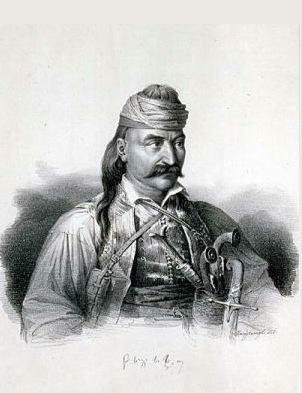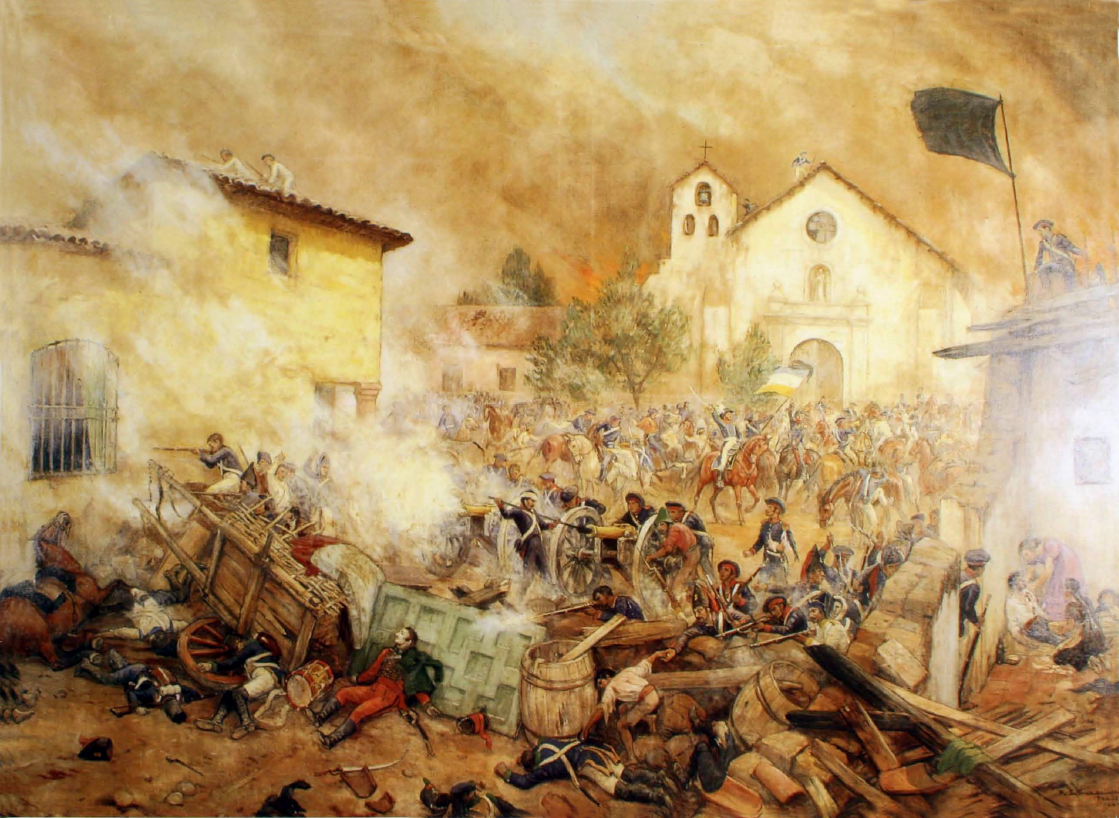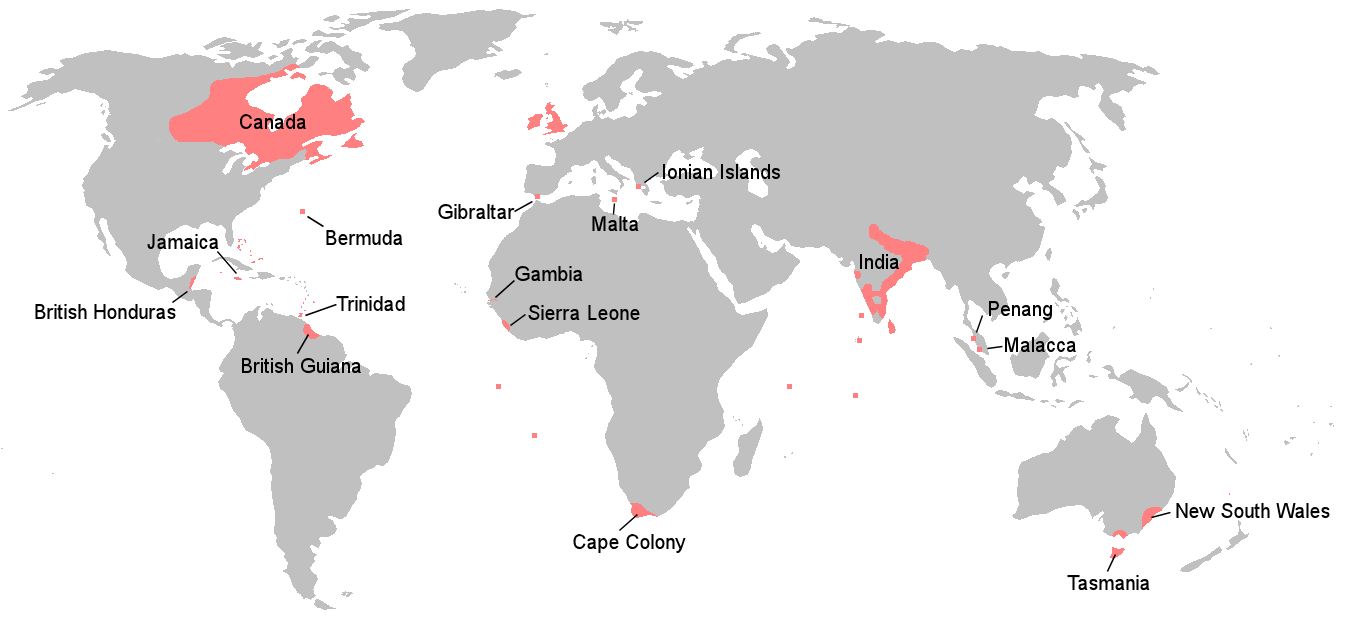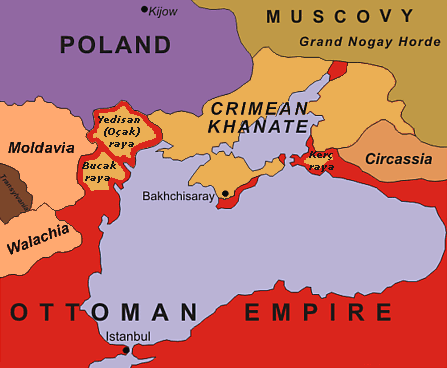|
Theodoros Kolokotronis
Theodoros Kolokotronis (; 3 April 1770 – ) was a Greek general and the pre-eminent leader of the Greek War of Independence (1821–1829) against the Ottoman Empire. The son of a klepht leader who fought the Ottomans during the Orlov revolt, Kolokotronis also operated as a klepht and an armatolos early in his life. While serving in the British army during the Napoleonic Wars, he became influenced by the revolutionary ideas of the era. On the outbreak of the Greek War of Independence, he organized a band of Moreot klephts and captured Tripolitsa in late 1821. Kolokotronis achieved his greatest success at the 1822 Battle of Dervenakia, where he routed the Ottoman forces under the command of Mahmud Dramali Pasha. From 1823 to 1825, he took part in the Greek civil wars and, following the defeat of his faction, he was briefly imprisoned in Hydra. In 1825, Kolokotronis was released and appointed commander-in-chief of the Greek forces in Peloponnese. He defended Greece agains ... [...More Info...] [...Related Items...] OR: [Wikipedia] [Google] [Baidu] [Amazon] |
Dionysios Tsokos
Dionysios Tsokos (Greek: Διονύσιος Τσόκος; c. 1814/1820 in Zakynthos – 1862 in Athens) was a Greek painter; one of the first to gain recognition in the post-Ottoman period. He is mostly known for portraits and historical scenes which combine elements from the Heptanese School with Italian styles. Biography His parents came from Epirus. He took his first painting lessons from Nikolaos Kantounis,Brief biography @ the National Gallery of Greece. who was living in exile on a small island near . Kantounis not only taught him to paint, but infused him with nationalistic feelings as well. His activities over the next few years are unclear, but by 1844, he was in Venice, attending c ... [...More Info...] [...Related Items...] OR: [Wikipedia] [Google] [Baidu] [Amazon] |
Major (rank)
Major is a senior military Officer (armed forces), officer military rank, rank used in many countries. When used unhyphenated and in conjunction with no other indicators, major is one rank above Captain (land), captain in armies and air forces, and one rank below lieutenant colonel. It is considered the most junior of the senior officer ranks. Background Etymologically, the word stems from the Latin word meaning "greater". The rank can be traced back to the rank of sergeant major general, which was shortened to sergeant major, and subsequently shortened to ''major''. When used in hyphenated or combined fashion, the term can also imply seniority at other levels of rank, including major general, denoting a low-level general officer, and sergeant major, denoting the most senior non-commissioned officer (NCO) of a military unit. The term major can also be used with a hyphen to denote the leader of a military band such as in Pipe-Major, pipe-major or drum-major. Links to major ... [...More Info...] [...Related Items...] OR: [Wikipedia] [Google] [Baidu] [Amazon] |
Battle Of Nauplia (1822)
The Battle of Nauplia, also known as the Battle of Spetses, was a series of naval engagements lasting from 8 to 13 September ( O.S.) 1822 in the Gulf of Nauplia (Argolic Gulf) between the Greek Fleet and the Ottoman Navy during the Greek War of Independence. Although neither side sustained significant losses (according to general descriptions, it consisted of distant and ineffectual cannonade between the two fleets), the Ottomans withdrew after three failed attempts to break through the Greek fleet, and the battle is considered a Greek victory. The Ottoman fleet of eighty-four vessels under the command of Kara Mehmet Pasha (also known as Mohammed Ali) was sent to destroy Greek forces at Hydra and Spetses and to relieve the besieged Ottoman garrison at Nauplia (Nafplio). Admiral Andreas Miaoulis commanded the Greek fleet. Miaoulis based his strategy on an ancient Greek admiral, Themistocles, in the Battle of Salamis, hoping to lure the superior Ottoman fleet into a narrow s ... [...More Info...] [...Related Items...] OR: [Wikipedia] [Google] [Baidu] [Amazon] |
Siege Of Acrocorinth
A siege () . is a military blockade of a city, or fortress, with the intent of conquering by attrition, or by well-prepared assault. Siege warfare (also called siegecrafts or poliorcetics) is a form of constant, low-intensity conflict characterized by one party holding a strong, static, defensive position. Consequently, an opportunity for negotiation between combatants is common, as proximity and fluctuating advantage can encourage diplomacy. A siege occurs when an attacker encounters a city or fortress that cannot be easily taken by a quick assault, and which refuses to surrender. Sieges involve surrounding the target to block provision of supplies and reinforcement or escape of troops (a tactic known as "investment"). This is typically coupled with attempts to reduce the fortifications by means of siege engines, artillery bombardment, mining (also known as sapping), or the use of deception or treachery to bypass defenses. Failing a military outcome, sieges can often be deci ... [...More Info...] [...Related Items...] OR: [Wikipedia] [Google] [Baidu] [Amazon] |
Siege Of Tripolitsa
The siege of Tripolitsa or fall of Tripolitsa (, ), also known as the Tripolitsa massacre (), was an early victory of the revolutionary Greek forces in the summer of 1821 during the Greek War of Independence, which had begun earlier that year, against the Ottoman Empire. Tripolitsa was an important target, because it was the administrative center of the Ottomans in the Peloponnese. Following the capture of the city by Greek revolutionary forces, the Muslim and Jewish population was massacred. Background Situated at the center of the Peloponnese, Tripolitsa was the pre-eminent town in southern Greece, and the capital of the Morea Eyalet (first-level province of the Ottoman Empire) since 1786, which made it an important target for the Greek revolutionaries. Many rich Turks and Jews lived there, together with Ottoman refugees, such as Turks and Albanians from Vardounia (Βαρδούνια), who had been driven there by the outbreak of the revolt and escaped massacres in the co ... [...More Info...] [...Related Items...] OR: [Wikipedia] [Google] [Baidu] [Amazon] |
Battle Of The Trench (1821)
The Battle of the Trench () was fought near Tripolitsa in Arcadia in August 1821 between the Greek revolutionary forces led by Theodoros Kolokotronis and the Ottoman garrison of Tripolitsa during the first year of the Greek War of Independence. The battle ended with the complete victory of the Greeks. Prelude In August 1821, the Greeks began the siege of Tripolitsa. The Ottomans who were besieged in the city attempted several night sallies in order to find supplies. When Theodoros Kolokotronis Theodoros Kolokotronis (; 3 April 1770 – ) was a Greek general and the pre-eminent leader of the Greek War of Independence (1821–1829) against the Ottoman Empire. The son of a klepht leader who fought the Ottomans during the Orlov revolt ... was called by the Greek revolutionaries to take over command of the siege, he ordered the digging of a trench (''grana'') one meter deep and two meters wide running from Mytikas in the village of Benteni up to the hill near the village o ... [...More Info...] [...Related Items...] OR: [Wikipedia] [Google] [Baidu] [Amazon] |
Battle Of Valtetsi
The Battle of Valtetsi was fought on 24 May, 1821 in Valtetsi between the Ottoman army and Greek revolutionaries. Background The Greek War of Independence officially began on 25 March 1821. During the war, the city of Tripoli in Arcadia, central Peloponnesus, became a prime objective of the Greek revolutionary army. Only the warlike Maniots were experts in the art of battle. Besides the Maniots, only the Klephts who lived in the mountains and the Armatoloi, who had for centuries been hired by the local Turkish authorities initially to guard the mountain passes and later for the general keeping of law and order, were coherent military forces. During April 1821, the initially small Greek forces in the area were slowly augmented by men from the nearby villages who declared Kolokotronis as Archistratigos, the man of overall command. Immediately, Kolokotronis established armed camps near the villages of Levidi, Piana, Chrysovitsi, Vervena and Valtetsi which were former rebe ... [...More Info...] [...Related Items...] OR: [Wikipedia] [Google] [Baidu] [Amazon] |
Greek War Of Independence
The Greek War of Independence, also known as the Greek Revolution or the Greek Revolution of 1821, was a successful war of independence by Greek revolutionaries against the Ottoman Empire between 1821 and 1829. In 1826, the Greeks were assisted by the British Empire, Bourbon Restoration in France, Kingdom of France, and the Russian Empire, while the Ottomans were aided by their vassals, especially by the Eyalet of Egypt. The war led to the formation of modern Greece, which would be expanded to its modern size in later years. The revolution is celebrated by Greek diaspora, Greeks around the world as Greek Independence Day, independence day on 25 March. All Greek territory, except the Ionian Islands, the Mani Peninsula, and mountainous regions in Epirus, came under Ottoman rule in the 15th century. During the following centuries, there were Ottoman Greece#Uprisings before 1821, Greek uprisings against Ottoman rule. Most uprisings began in the independent Greek realm of the Mani Pe ... [...More Info...] [...Related Items...] OR: [Wikipedia] [Google] [Baidu] [Amazon] |
Siege Of Santa Maura (1810)
The siege of Santa Maura in March and April 1810 was fought between the British and the French troops on the island of Lefkada (then known as Santa Maura). Santa Maura had belonged to the First French Empire since 1807, and was garrisoned by a mixed force of French regulars and men of the locally raised, Greco-Albanian Albanian Regiment. The British troops that landed on the island were also supported by Greek and Corsican volunteer troops. Mistrust of the Greco-Albanian troops by the French command, and the presence of Greeks in the British force, resulted in the defection of the Albanian Regiment's men to the British, hastening the surrender of the island. Background The island of Santa Maura, along with the other Ionian Islands, fell under French rule in 1807, after the Treaty of Tilsit. In October 1809, the British attacked and captured the islands of Zakynthos (Zante), Cephalonia, Kythira (Cerigo), and Ithaca. These islands were defended by small garrisons, with a few do ... [...More Info...] [...Related Items...] OR: [Wikipedia] [Google] [Baidu] [Amazon] |
Adriatic Campaign Of 1807–1814
The Adriatic campaign of 1807–1814 was a minor Theater (warfare), theatre of war of the Napoleonic Wars in which the Royal Navy, assisted by Austrian, Montenegrin and Greek troops, attacked the combined forces of the First French Empire, Kingdom of Italy (Napoleonic), Kingdom of Italy and Kingdom of Naples in the Adriatic Sea from 1807 to 1814. Much of the region was under direct or indirect French control, coming under France's domination as a result of Treaty of Pressburg (1805), Treaty of Pressburg which brought an end to the War of the Third Coalition. Control of the Adriatic brought numerous advantages to the French Navy, allowing rapid transit of troops from Italy to the Balkans and Austria for campaigning in the east and giving France possession of numerous shipbuilding facilities, particularly the large naval yards of Venice. From 1807, when the Treaty of Tilsit precipitated a Russian withdrawal from the Septinsular Republic, the French Navy held naval supremacy in th ... [...More Info...] [...Related Items...] OR: [Wikipedia] [Google] [Baidu] [Amazon] |
Napoleonic Wars
{{Infobox military conflict , conflict = Napoleonic Wars , partof = the French Revolutionary and Napoleonic Wars , image = Napoleonic Wars (revision).jpg , caption = Left to right, top to bottom:Battles of Battle of Austerlitz, Austerlitz, Fall of Berlin (1806), Berlin, Battle of Friedland, Friedland, Battle of Aspern-Essling, Aspern-Essling, French occupation of Moscow, Moscow, Battle of Leipzig, Leipzig and Battle of Paris (1814), Paris , date = {{start and end dates, 1803, 5, 18, 1815, 11, 20, df=yes({{Age in years, months, weeks and days, month1=05, day1=18, year1=1803, month2=11, day2=20, year2=1815) , place = Atlantic Ocean, Caucasus, Europe, French Guiana, Mediterranean Sea, North Sea, West Indies, Ottoman Egypt, Egypt, East Indies. , result = Coalition victory , combatant1 = Coalition forces of the Napoleonic Wars, Coalition forces:{{flagcountry, United Kingdom of Great Britain and ... [...More Info...] [...Related Items...] OR: [Wikipedia] [Google] [Baidu] [Amazon] |
Russo-Turkish War (1806–12)
The Russo-Turkish wars ( ), or the Russo-Ottoman wars (), began in 1568 and continued intermittently until 1918. They consisted of twelve conflicts in total, making them one of the longest series of wars in the history of Europe. All but four of these wars ended in losses for the Ottoman Empire, which was undergoing a period of stagnation and decline. Conversely, they showcased the ascendancy of the Russian Empire as a significant European power after Peter the Great oversaw extensive modernization efforts in the early 18th century. Ultimately, however, the end of the Russo-Turkish wars came about with the dissolution of the two belligerents' respective states as a consequence of World War I: the Russian Empire collapsed in 1917 and was ultimately succeeded by the Union of Soviet Socialist Republics in 1922; while the Ottoman Empire was partitioned between 1918 and 1922 and succeeded by the Republic of Turkey in 1923. History Initial and intermediate phases (1568–1739) ... [...More Info...] [...Related Items...] OR: [Wikipedia] [Google] [Baidu] [Amazon] |






